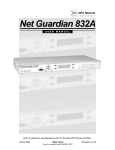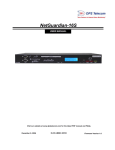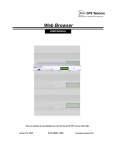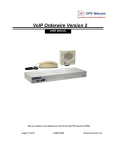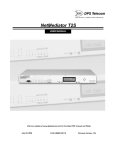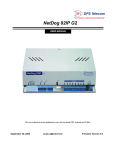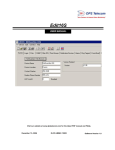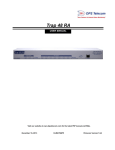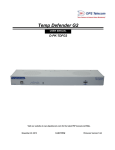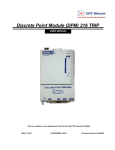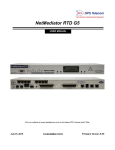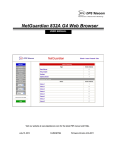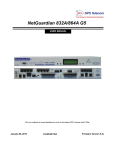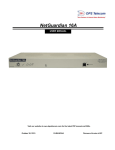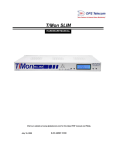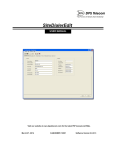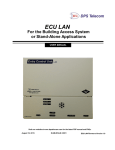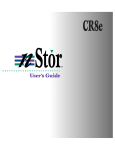Download NetGuardian 216
Transcript
NetGuardian 216 USER MANUAL Visit our website at www.dpstelecom.com for the latest PDF manual and FAQs. March 17, 2008 D-OC-UM083.17110 Firmware Version 2.0I Revision History March 17, 2008 Added RS-232 Bridging port pinout diagram. July 1, 2005 NetGuardian 216 User Manual (D-OC-UM057.01100) released. Supports Firmware Version 1.0. October 31, 2005 NetGuardian 216 User Manual (D-OC-UM05A.31100) released. Support for DCP reporting over T202 modem added. November 4, 2005 NetGuardian 216 User Manual D-OC-UM05B.04100 released. Supports Firmware version 2.0, Improvements to Firmware Load added. June 2, 2006 NetGuardian 216 User Manual released. Updated 202 Tune Modem section. This document contains proprietary information which is protected by copyright. All rights are reserved. No part of this document may be photocopied without prior written consent of DPS Telecom. All software and manuals are copyrighted by DPS Telecom. Said software and manuals may not be reproduced, copied, transmitted or used to make a derivative work, by either mechanical, electronic or any other means in whole or in part, without prior written consent from DPS Telecom, except as required by United States copyright laws. © 2008 DPS Telecom Notice The material in this manual is for information purposes and is subject to change without notice. DPS Telecom shall not be liable for errors contained herein or consequential damages in connection with the furnishing, performance, or use of this manual. Contents Visit our website at www.dpstelecom.com for the latest PDF manual and FAQs 1 NetGuardian 216 Overview 1 2 Shipping List 2 3 Specifications 4 4 Installation 5 4.1 Tools Needed 5 4.2 Mounting 5 4.3 Power Connection 6 4.4 LAN Connection 6 4.5 Discrete Alarms 8 4.6 50-Pin Alarm and Control Relay Connector 9 4.6.1 50-Pin Connector Pinout Table 4.6.2 50-Pin Connector Pinout Diagram 9 10 4.7 Optional Wire-Wrap Back Panel 11 4.8 Optional 66 Block Connector 12 4.9 Analog Alarms 13 4.9.1 Optional 4-Pin Analog Connector 13 4.9.2 Switching Analog Alarms to Current Operation 14 4.10 Back Panel Serial Port 15 4.11 Craft Port 17 5 T/NG216 Configuration Software 18 5.1 T/NG216 PC Requirements 18 5.2 Starting T/NG216 — You MUST Read This Section 19 5.3 Changing Modes in T/NG216 20 5.4 Connecting to the NetGuardian 216 via Craft Port 21 5.5 Connecting to the NetGuardian 216 via LAN 23 5.5.1 Assigning an IP Address via Craft Port 25 5.5.2 Assigning an IP Address via Temporary LAN Connection 26 6 Configuration 29 6.1 T/NG216 Editor Mode 29 6.2 Reading and Writing Configuration Files on PC Disk 29 6.3 Reading and Writing Configuration Files to NetGuardian 216 NVRAM 30 6.4 Device Tab: General NG216 Options 31 6.4.1 Ethernet Port Options 32 6.4.2 NG216 Options: Password and Alarm Speaker 32 6.5 Channel Tab: Alarm Reporting Options 6.5.1 DCP Channel: T/Mon NOC Alarm Reporting Options 33 33 6.5.1.1 6.5.1.2 Reporting to T/Mon NOC via LAN 33 Reporting to T/Mon NOC via Serial or T202 Modem Connection 34 6.5.2 Reach-through Channel 35 6.5.3 Alarm Channel: SNMP Alarm Reporting Options 36 6.6 Alarms Tab: Alarm Descriptions, Polarity and Trap Options 37 6.7 Relays Tab: Control Relay Options 37 6.8 System Alarms Tab 38 6.9 Analog Alarms Tab 39 6.9.1 Analog Channel Scaling Reference Tool 7 Turn-up and Test Mode 40 41 7.1 Alarm Tab: Monitor and Log Alarms 42 7.2 Analog Tab: Display Live Analog Values 43 7.3 Relays Tab: Test Control Relay Action 43 7.4 Date/Time Tab: Set and Synchronize Clock 44 7.5 Tuning Tab: 202 Modem Tuning 44 8 Analyze Mode 45 9 Firmware Load 46 9.1 Troubleshooting Firmware Load 47 9.2 Firmware Load: Legacy Mode 48 9.3 LED Display During Firmware Load 49 10 Front and Back Panel LEDs 49 11 Alarm Speaker 51 12 Reference Section 52 12.1 NetGuardian 216 Alarm Map 52 12.2 NetGuardian 216 Trap OIDs 53 12.3 SNMP Granular Trap Packets 55 13 Technical Support 56 1 1 NetGuardian 216 Overview Fig 1.1. Compact, easy-to-install, right-size capacity — the NetGuardian 216 makes it cost-effective to monitor every site in your network. Effective, easy-to-install, light-capacity alarm monitoring The NetGuardian 216 is a compact, LAN-based light-capacity remote telemetry unit. The NG216 is designed for easy installation at small remote sites, making it cost-effective to deploy alarm monitoring throughout your entire telecom network. Right-size capacity for small sites The NG216 is scaled to the needs of small sites like remote huts, collocation racks and enclosed cabinets — anyplace where a large-capacity RTU would be more than you need. · 16 discrete alarm inputs · 2 analog alarm inputs · 2 control relays Reach-through serial port gives LAN access to on-site equipment The NG216 also features a reach-through serial port. This port provides remote users with LAN-based Telnet access to a variety of on-site telecom equipment, including switches, radios, PBXs and many other devices. SNMP or T/Mon NOC The NetGuardian 216 can report alarms to any SNMP manager or to the DPS Telecom T/Mon NOC Remote Alarm Monitoring System. The NG216 can report SNMP over UDP or TCP and can report to T/Mon NOC over UDP, TCP, serial port or T202 modem connection. Easy installation and configuration Since it's LAN-based, the NetGuardian 216 installs quickly and easily, without the expense of laying dedicated lines. The unit mounts in any 19" or 23" rack and occupies only 1 RU. The unit has simple rear-panel connectors for alarm inputs. The NG216 ships with T/NG216, a free Windows-based configuration utility. You can configure and provision the unit on-site through the craft port or remotely over LAN — so you don't have to physically drive to the site just to change a setting. The NetGuardian 216 stores its configuration information in nonvolatile RAM, where it is retained even if the unit loses power. 2 2 Shipping List Please make sure all of the following items are included with your NetGuardian 216. If parts are missing, or if you ever need to order new parts, please refer to the part numbers listed and call DPS Telecom at 1-800-622-3314. NetGuardian 216 D-PK-NG216 NetGuardian 216 User Manual (PDF Manual, MIBs and T/NG216 Software) 6 ft. DB9M-DB9F Download Cable D-PR-045-10A-04 19" Rack Ear x4 Four 3/8" Ear Screws NetGuardian 216 Resource CD 14 ft. Ethernet Cable D-PR-923-10A-14 Wall Mount Bracket x2 Two Standard Rack Screws 3 x2 Two Metric Rack Screws Power Connector Plug Pads Two 1/2-Amp GMT Fuse 4-Pin Connector Plug 4 3 Specifications Discrete Alarm Inputs: 16 (reversible) Analog Alarm Inputs: 2 Analog Input Range: –90 to 90 VDC or 4 to 20 mA Analog Thresholds: 4 Control Relays: 2 Protocols: SNMP DCPx, DCPf, DCP, DCP1 (T/Mon NOC reporting) Dimensions: 1.720" H x 8.375" W x 6.626" D (4.369 cm x 21.273 cm x 16.830 cm) 1.720" H x 10.489" W x 6.636" D (4.369 cm x 26.641 cm x 16.855 cm) Weight: 1.8425 lb (Wide-Case model) Normal NG216 Case NG216 Wide Case Mounting: 19" or 23" rack Power Input: –48 VDC (–48 to –70 VDC) Optional -48 VDC from 110 VAC wall transformer Current Draw: 200 mA Fuse: 1/2 Amp GMT Interfaces: 1 RJ45 10BaseT Ethernet port 1 50-pin connector (alarm inputs and control outputs) 1 4-pin connector (analog alarm inputs) 1 DB9 front-panel craft port 1 DB9 serial port Visual Interface: 8 LEDs Audible Notification: Alarm speaker with volume control and silence button Operating Temperature: 32°–140° F (0°–60° C) Operating Humidity: 0%–95% noncondensing 5 4 Installation 4.1 Tools Needed To install the NetGuardian, you'll need the following tools: Phillips No. 2 Screwdriver Small Standard No. 2 Screwdriver PC with T/NG216 installed 4.2 Mounting Fig. 4.2.1. The NetGuardian 216 can be flush or rear-mounted The compact NetGuardian 216 occupies only half the width of a standard rack unit. Only one rack ear is supplied with the NetGuardian 216, and the rack ear can be mounted on the left or right side of the unit. The NetGuardian 216 mounts in a 19" or 23" rack, and can be mounted on the right or left, in the flush-mount or rear mount locations, as shown in Figure 4.2.1. The rack ears can be rotated 90° for wall mounting or 180º for other mounting options not shown. Use the included wall mount bracket to mount the NetGuardian 216 vertically on the wall. 6 4.3 Power Connection Fig. 4.3.1. Power connector. The NetGuardian 216's power connector is a screw terminal barrier plug, located on the left side of the back panel. (See Figure 4.3.1) Before you connect a power supply to the NetGuardian 216, test the voltage of your power supply: · Connect the black common lead of a voltmeter to the ground terminal of the battery, and connect the red lead of the voltmeter to the battery's –48 VDC terminal. The voltmeter should read between –43 and –53 VDC. If the reading is outside this range, test the power supply. To connect the NetGuardian to a power supply, follow these steps: 1. Remove the fuse from the front panel of the NetGuardian 216. Do not reinsert the fuse until all power and network connections have been made. 2. Remove the power connector plug from the NetGuardian 216's power connector. Note that the plug can be inserted into the power connector only one way — this ensures that the barrier plug can only be reinserted with the correct polarity. Note that the –48V terminal is on the left and the GND terminal is on the right. 3. Insert a battery ground into the power connector plug's right terminal and tighten the screw; then insert a –48 VDC line to the plug's left terminal and tighten its screw. 4. Push the power connector plug firmly back into the power connector. 5. Reinsert the fuse to power up the NetGuardian 216. The PWR LED by the power connector will light GREEN. The front panel LEDs will flash RED and GREEN. 4.4 LAN Connection 7 Fig. 4.4.1. Ethernet port To connect the NetGuardian 216 to the LAN, insert a standard RJ45 Ethernet cable into the 10BaseT Ethernet port on the back of the unit. (See Figure 4.4.1.) If the LAN connection is OK, the LNK LED will light SOLID GREEN. RJ45 Ethernet Connection 8 7 6 5 4 3 2 1 Receive In– (RI–) Receive In + (RI+) Transmit Out– (TO–) Transmit Out + (TO+) Fig. 4.4.2 Ethernet connection pinout The pinout for the RJ45 connection is shown in Figure 4.4.2, above. 8 4.5 Discrete Alarms Dry Contact Contact to Ground NetGuardian 216 case NetGuardian 216 case GND GND Alarm Alarm – Batt. – Batt. Note: Make sure that grounds have a common reference — this is usually done by tying grounds together. Fig. 4.5.1. Discrete alarm points can connect as a dry contact or a contact to ground The NetGuardian 216 features 16 discrete alarm inputs — also called digital inputs or contact closures. Discrete alarms are either activated or inactive, so they're typically used to monitor on/off conditions like power outages, equipment failures, door alarms and so on. The NetGuardian 216's discrete alarm points are single-lead signals referenced to ground. The ground side of each alarm point is internally wired to ground, so alarm points can connect either as a dry contact or a contact to ground. In a dry contact alarm, the alarm lead brings a contact to the ground lead, activating the alarm. In a contact to ground alarm, a single wire brings a contact to an external ground, activating the alarm. For a diagram, see Figure 4.5.1, above. You can reverse the polarity of each individual discrete alarm point, so that the alarm is activated when the contact is open. To reverse the polarity of an alarm point, use the included T/NG216 configuration software. For instructions, see Section 6.6, "Alarms Tab: Alarm Description, Polarity and Trap Options." 9 4.6 50-Pin Alarm and Control Relay Connector Fig. 4.6.1. Main 50-pin alarm and control relay connector The primary connector for discrete alarms, analog alarms and control relays is the 50-pin connector on the NetGuardian 216's back panel. (See Figure 4.6.1, above.) Note: You can optionally connect analog inputs through the 4-pin barrier plug connector, instead of the 50-pin connector. For more information, see Section 4.8.1, "Optional 4-Pin Analog Alarm Connector." 4.6.1 50-Pin Connector Pinout Table Discretes 1–16 Control Relays 1–2* GND ALM ALM 1 1 26 ALM 2 2 27 ALM 3 3 28 ALM 4 4 29 ALM 5 5 30 ALM 6 6 31 ALM 7 7 32 ALM 8 8 33 ALM 9 9 34 ALM 10 10 35 ALM 11 11 36 ALM 12 12 37 ALM 13 13 38 ALM 14 14 39 ALM 15 15 40 ALM 16 16 41 Analogs 1–2 NO NC CO CTRL 1 17 42 43 CTRL 2 19 44 18 + – ANA 1 23 48 ANA 2 24 49 Fuse Alarm** FA GND NO CO 20 45 GND 25 * NO = Normally Open, NC = Normally Closed, CO = Common ** Control relay is closed if fuse blows. Table 4.6.1.A. 50-pin connector pinout 50 10 4.6.2 50-Pin Connector Pinout Diagram GND 1 GND 2 GND 3 GND 4 5 GND GND 6 7 GND 8 GND 9 GND 10 GND GND 11 GND 12 13 GND GND 14 GND 15 GND 16 CTRL 1 NO 17 CTRL 2 CO 18 CTRL 2 NO 19 FA NO 20 21 Unused Unused 22 ANA 1 + 23 24 ANA 2 + 25 GND ALM 1 26 27 ALM 2 28 ALM 3 29 ALM 4 30 ALM 5 31 ALM 6 32 ALM 7 33 ALM 8 34 ALM 9 35 ALM 10 ALM 11 36 ALM 12 37 ALM 13 38 ALM 14 39 40 ALM 15 41 ALM 16 42 CTRL 1 NC 43 CTRL 1 CO 44 CTRL 2 NC 45 FA CO 46 Unused Unused 47 ANA 1 – 48 49 ANA 2 – 50 GND ALM = Alarm ANA = Analog CTRL = Control Relay GND = Ground FA = Fuse Alarm NO = Normally Open NC = Normally Closed CO = Common Fig. 4.6.2.1. 50-pin connector pinout 11 4.7 Optional Wire-Wrap Back Panel Fig. 4.7.1 The wire-wrap back panel The optional wire-wrap back panel provides wire-wrap connections for the NetGuardian's alarms (discrete and analog) and control relays. Screw the board into the holes on either side of the "Discretes 1-16/Analogs 1-4/Relays 1-2 connector" (as shown in Figure 4.7.1). To connect discrete alarms, analog alarms, and control relays to the wire-wrap panel, connect them to the pin block on the front of the panel. Caution: Analog Channels 3 and 4 on the Wire-Wrap Panel correspond to Analog Channels 1 and 2 on the NetGuardian. 12 4.8 Optional 66 Block Connector Fig. 4.8.1. Optional 66 block connector pinout The NetGuardian 216 is also available with an optional 66 Block Connector for connecting discrete alarms, analog alarms and control relays. Pinout and wire color coding for the 66 Block are shown in Figure 4.8.1. 13 4.9 Analog Alarms The NetGuardian's two analog alarm inputs measure continuous ranges of voltage or current. Analog alarms are typically used to monitor battery voltage, charging current, temperature or other continuously variable conditions. The measurement range of the analog channels is –90 to +90 VDC or 4 to 20 mA. You can connect analog alarm inputs to the NetGuardian 216 by using either the main 50-pin connector or the optional 4-pin analog alarm connector. For the 4-pin analog connector's pinout information, see Section 4.8.1, "Optional 4-Pin Analog Connector." By default, the analog inputs are configured to measure voltage. You can switch the analog inputs to measure current by resetting jumpers on the NetGuardian 216's circuit board. For instructions, see Section 4.8.2, "Switching Analog Alarms to Current Operation." 4.9.1 Optional 4-Pin Analog Connector Fig. 4.8.1.1. 4-pin analog alarm input connector The 4-pin analog alarm input connector provides an optional connection for analog alarms only. You can connect analog inputs to EITHER the primary 50-pin alarm connector OR the 4-pin connector, but not both at the same time. The 4-pin connector is a screw terminal barrier plug similar to the power connector. To connect analog inputs, remove the connector plug, connect the leads to the appropriate terminals and reinsert the barrier plug. Note that the plug can be inserted into its socket only one way — this ensures that the connector plug can only be reinserted with the alarm inputs aligned correctly. Analogs 1A 2A 1B 2B ANA 1 + ANA 2 – ANA 1 – ANA 2 + Fig. 4.8.1.2. 4-pin analog connector pinout The pinout for the 4 pin analog connector is shown in Figure 4.8.1.2, above. 14 4.9.2 Switching Analog Alarms to Current Operation Fig. 4.8.2.1. Adjustable jumpers on the NetGuardian 216 circuit board By default, the analog inputs are configured to measure voltage. You can switch the analog inputs to measure current by resetting jumpers on the NetGuardian 216's circuit board. To rest the analog alarm voltage/current jumpers, follow these steps: 1. Make sure the NetGuardian 216 is depowered and disconnected from all network connections. 2. Remove the screws from the sides of the NetGuardian 216 case. 3. Slide the top cover of the case off to expose the circuit board. 4. The adjustable jumpers are shown in Figure 4.8.2.1. Both alarm inputs can be individually configured for current or voltage operation. CAUTION: The Jumper labeled Analog 3 controls the voltage/current settings for Analog Input 1, and the Jumper labeled Analog 4 controls Analog Input 2. Jumper installed for current Current + 250 Ohm Shunt - 4 to 20 mA Current Source Transducer Analog Channel Input Jumper removed for voltage Voltage + Voltage Source Transducer Analog Channel Input Unjumpered/Open Position: Voltage Operation (default) Jumpered/Closed Position: Current Operation - Fig. 4.8.2.2. Jumper settings for analog alarms inputs 15 5. By default, both jumpers are in the unjumpered/open position, which corresponds to voltage operation, as shown in Figure 4.8.2.2. To reset an analog alarm input to current operation, reset its jumper in the closed position. Note: Each jumper inserts a 250-ohm shunt resistor across the input. This must be taken into account when defining the analog input reference scale. For more information, see Section 6.9.1, "Analog Channel Scaling Reference Tool." 6. Slide the top cover of the case back into position and replace the screws. 7. Reconnect and power up the NetGuardian 216. 4.10 Back Panel Serial Port Fig. 4.9.1. Serial port The NetGuardian 216's DB9 RS-232 reach-through serial port is located on the back panel, where it is labeled "Primary," as shown in Figure 4.9.1. The serial port can be used for three different functions: · Reach-through proxy connection for LAN-based Telnet access to switches, radios, PBXs and other equipment · Alarm reporting to the T/Mon NOC Remote Alarm Monitoring System over an RS-232 serial line · Alarm reporting to T/Mon NOC over a T202 modem connection Note: If the serial port is configured for alarm reporting to T/Mon NOC, the port is not available for use as a reach-through proxy port. For instructions on configuring the serial port, see Section 6.5.1, "DCP Channel: T/Mon NOC Alarm Reporting Options," and Section 6.5.2, "Reach-through Channel." 16 When used as a reach-through proxy port, the serial port has the pinout shown in Figure 4.9.2, below. RX TX GND 5 4 3 2 1 9 8 7 6 RTS CTS DB9F RS-232 Pin # Signal Description 1 2 3 4 5 6 7 8 9 NC TX RX DSR GND NC CTS RTS NC Not connected Transmit data Receive data Data set ready Ground Not connected Clear to send Request to send Not connected Fig. 4.9.2. Reach-through proxy port pinout When used as a T202 modem port (optional), the serial port has the pinout shown in Figure 4.9.3, below. RX+ TX+ 5 4 3 2 1 9 8 7 6 TX– RX– DB9F T202 Port Pin # Signal Description 1 2 3 4 5 6 7 8 9 TX+ NC NC RX+ NC TX– NC NC RX– Transmit positive Not connected Not connected Receive positive Not conntected Transmit negative Not connected Not connected Receive negative Fig. 4.9.3. T202 modem port pinout When using a RS-232 Bridging Docking Pad (optional), the serial port has the pinout shown in Figure 4.9.4, below. BRX HRX GND 5 4 3 2 1 9 8 7 6 HTX BTX DB9F RS-232 Port Pin # Signal Description 1 2 3 4 5 6 7 8 9 HRX NC NC BRX GND BTX NC NC HTX Host receive data Not connected Not connected Bridge receive data Ground Bridge transmit data Not connected Not connected Host transmit data Fig. 4.9.4. RS-232 Bridging port pinout 17 4.11 Craft Port Fig. 4.10.1. Craft port Use the front panel craft port to connect the NetGuardian 216 to a PC for onsite unit configuration. To use the craft port, connect the included DB9 download cable from your PC's COM port to the craft port. For instructions on using the included T/NG216 configuration software, see Section 5, "T/NG216 Configuration Software." RX TX GND 5 4 3 2 1 9 8 7 6 RTS CTS DB9F RS-232 Pin # Signal Description 1 2 3 4 5 6 7 8 9 NC TX RX DSR GND NC CTS RTS NC Not connected Transmit data Receive data Data set ready Ground Not connected Clear to send Request to send Not connected Fig. 4.10.2. Craft port pinout The craft port pinout is shown in Figure 4.10.2, above. 18 5 T/NG216 Configuration Software T/NG216, the Windows-based software utility included with your NetGuardian 216, provides a full suite of tools for unit configuration, turnup and testing. With T/NG216, you can: · Configure and provision the NetGuardian 216 · Read and write configuration files to NetGuardian 216 units in the field over LAN or local craft port connection · Create and save configuration files to your local PC — this is great if you want to create a standard configuration for all your NG216 units, or if you want to create batches of configuration files for remote LAN upload · Monitor alarm points and operate control relays for turnup and testing · Monitor live, real-time voltage or current values from the NetGuardian 216's analog alarm inputs · Analyze network traffic between the NetGuardian 216 and its alarm master · Load firmware updates To install T/NG216 on your PC, run the installer program included on the NetGuardian 216 Resource CD. 5.1 T/NG216 PC Requirements To run T/NG216, DPS Telecom recommends a Windows-based PC with the following specifications: Operating System: Windows 9x, NT, ME, 2000 or XP Processor: 333 MHz or better Color Setting: 16 bit Screen Resolution: 1024 x 768 Note: T/NG216 may not work properly on slower machines if the display is set for 256 colors. 19 5.2 Starting T/NG216 — You MUST Read This Section Fig. 5.2.1. Select a mode … but first check your communication settings To start T/NG216, choose its program shortcut from the Windows Start menu. When T/NG216 starts, it will first display the mode selection dialog shown in Figure 5.2.1. Your choices are: Turn-up and Test: Monitor alarms, control relays and set date and time Editor: Configure options and provision NetGuardian 216 unit Analyze: View NetGuardian 216 communication in hexadecimal or ASCII format Load Firmware: Install firmware updates on the NetGuardian 216 Close: Start T/NG216 without choosing a mode ! Important! If you need to change T/NG216's communication settings, click CLOSE. If you select a mode, T/NG216's communication settings are LOCKED. By default, a new T/NG216 installation is configured to connect to the NetGuardian 216 over a physical cable connection between your PC's Communications Port 1 (COM1) and the NG216's front panel craft port. You CANNOT change this setting while in Turn-up and Test, Editor, Analyze or Load Firmware Mode. If you are connected to the NetGuardian 216 through a COM1–to–Craft Port connection, go ahead and select the mode you want to use. But keep in mind that T/NG216 saves communication settings between 20 sessions — if you ever change your communication settings, you should double-check your settings the next time you start the program. If you want to make a LAN connection to a remote NetGuardian 216, or if you want to connect to the craft port using a different PC COM port, click Close in the mode selection dialog. Change your communication settings, and then select the mode you want. (For more information, see Section 5.4, "Connecting to the NetGuardian 216 via Craft Port" and Section 5.5, "Connecting to the NetGuardian 216 via LAN.") 5.3 Changing Modes in T/NG216 Reboot Editor NG 216 Turn-up Analyze and Test Load Advanced Firmware Fig. 5.3.1. Change mode buttons on the T/NG216 toolbar While running T/NG216 you can change modes by clicking one of the change mode buttons in the T/NG216 toolbar. (See Figure 5.3.1.) The toolbar also features a button for rebooting the connected NetGuardian 216. In most cases, you won't need to reboot the NetGuardian 216 — if the unit needs to be rebooted to put an configuration change into effect, T/NG216 will automatically reboot the unit. If you point to a toolbar button with the mouse cursor, the button's name will appear in a tooltip by the cursor and in the status bar at the bottom of the T/NG216 window. Fig. 5.3.2. Exit mode button To exit a mode, click the Exit button on the far right of the toolbar. (See Figure 5.3.2, above.) ! Important! ALWAYS click Exit BEFORE changing communication settings. You CANNOT change communication settings while in Turn-up and Test, Editor, Analyze or Load Firmware Mode. 21 It's especially important to verify your communication settings when you are connecting to remote NetGuardian 216 units over LAN. After you enter Editor Mode and start entering configuration data, you cannot change the IP address — you are locked onto the last NetGuardian 216 you connected to, and if you click the Write to unit button, the new configuration will be written to the last IP address entered, overwriting your last configuration work. Fig. 5.3.3. Action menu You can also change modes by selecting a mode from the Action menu. (See Figure 5.3.3., above.) The Action menu also has a command for opening the Protocol Window. This is an internal DPS Telecom command that you won't need to use unless advised to by DPS Telecom Tech Support personnel. ! Important! The Action menu Exit command and the toolbar Exit button are two separate commands. The Action menu Exit command quits the T/NG216 program. The toolbar Exit button just exits the currently active mode. If you just want to change your communication settings, click the Exit button. 5.4 Connecting to the NetGuardian 216 via Craft Port Fig. 5.4.1. Craft port The simplest way to connect to the NetGuardian 216 is over a physical cable connection between your PC's Communications Port 1 (COM1) and the NG216's front panel craft port. Use the included DB9 download cable to connect your PC's COM port to the NetGuardian 216 craft port. (For the pinout of the craft port, see Section 4.10, "Craft Port.") 22 To connect over the craft port, just start T/NG216 and choose the mode you want to use. (See Section 5.2, "Starting T/NG216.") Fig. 5.4.2. Communications error message If T/NG216 can't connect to the NetGuardian 216, the program will display the error message shown in Figure 5.4.2, above. Make sure that the NetGuardian 216 unit is powered and double-check the cable connection. Fig. 5.4.3. Use the COM Port command on the Settings menu to switch to a different COM port If you want to connect to the NetGuardian 216 over a LAN connection or a different COM port, click the COM Port command on the Settings menu. (See Figure 5.4.3.) This opens the Communication Mode dialog box. (See Figure 5.4.4.) Fig. 5.4.3. Enter a different COM port number here Click Craft Port and enter a new number in the COM Port Number box. Note: T/NG216 saves communication settings between sessions, so when you next start T/NG216, the program will be configured to use the last communication settings used. ! Important! You CANNOT change T/NG216's communication settings while in Turn-up and Test, Editor, Analyze or 23 Load Firmware Mode. Before changing communication settings, click EXIT on the T/NG216 Toolbar. When T/NG216 is in Turn-up and Test, Editor, Analyze or Load Firmware Mode, the program's communication settings are LOCKED and cannot be changed. While T/NG216 is any of these modes, the program will read from and write to the NetGuardian 216 unit that is connected over the last communications channel used. If you always use a craft port connection, this isn't a problem, since you'll make a new physical cable connection every time you connect to a different NG216 unit. Just keep T/NG216 configured to use your preferred COM port (probably the default setting, COM1). Keep in mind that T/NG216 saves communication settings between sessions, so if you change your communication settings, double-check your settings the next time you start the program. For important information about LAN connections, see Section 5.5, "Connecting to the NetGuardian 216 via LAN." To close a mode and change communication settings, always click EXIT button on the TOOLBAR. If you choose the Exit command from the Action menu, you will quit the T/NG216 program. For more information, see Section 5.3, "Changing Modes in T/NG216." 5.5 Connecting to the NetGuardian 216 via LAN You can also use T/NG216 to remotely connect to NetGuardian 216 units in the field over LAN. This is a very convenient way to provision a series of NetGuardian units, especially if you're working from a standardized configuration file. [WARNING: When working with NetGuardian 216s over LAN, be very careful that you're connected to the correct unit BEFORE writing a configuration to unit memory. See important warnings at the end of this section.] Before you can make a remote LAN connection to the NetGuardian 216, you need to assign the NetGuardian 216 an IP address on your network. (If you're not sure what IP address to assign, check with your network administrator.) In order to assign the NetGuardian 216 an IP address, you have to establish a temporary connection to the unit. There are two ways to make a temporary connection to the NetGuardian 216: The Easy Way: If you have physical access to the NetGuardian 216, the easiest thing to do is connect to the unit through the craft port and then assign it an IP address. After you've done that, you can complete the rest of the unit configuration over a remote LAN connection, if you want. For instructions, see Section 5.5.1, "Assigning an IP Address via Craft Port." The Slightly More Complicated Way: If you DON'T have physical access to the NetGuardian, you can connect to the NetGuardian 216 over a temporary LAN connection. You can create a temporary connection by temporarily changing the IP address and subnet mask of your PC to match the factory-default settings of the NetGuardian 216. For instructions, see Section 5.5.2, "Assigning an IP Address via Temporary LAN Connection." 24 Once you have assigned an IP address to the NetGuardian 216, follow these steps to make a remote LAN connection to the unit: Fig. 5.5.1. Use the COM Port command on the Settings menu to select a LAN connection 1. Start T/NG216. Click Close in the mode selection dialog box. (See Section 5.2, "Starting T/NG216.") 2. Choose COM Port from the Settings menu to open the Communication Mode dialog box. (See Figure 5.5.1, above.) Fig. 5.5.2. Enter the NetGuardian 216's IP address here 3. In the Communications Mode dialog box, click TCP/IP. Type the NetGuardian 216's IP address in the IP Address box. The NetGuardian 216 always connects over LAN using Port 2002, so the Port box cannot be changed. Fig. 5.5.3. Communications error message 4. To verify the connection, switch to Turn-up and Test Mode, or switch to Editor Mode and click the Read from Unit button. (For information about switching modes, see Section 5.3.) If T/NG216 can't connect to the NetGuardian 216, the program will display the error message shown in Figure 5.4.2.4, above. If possible, make sure that the NetGuardian unit is powered and connected to the network. Check to make sure there are no firewalls or port-blocking routers between your PC and the NetGuardian 216. Note: T/NG216 saves communication settings between sessions, so when you next start T/NG216, the program will be configured with the last communications settings used. ! Important! You CANNOT change T/NG216's communication settings while in Turn-up and Test, Editor, Analyze or 25 Load Firmware Mode. Before changing communication settings, click EXIT on the T/NG216 Toolbar. When T/NG216 is in Turn-up and Test, Editor, Analyze or Load Firmware Mode, the program's communication settings are LOCKED and cannot be changed. While T/NG216 is any of these modes, the program will read from and write to the NetGuardian 216 unit that was connected over the last communications channel used. When connecting to NetGuardian 216 units through a LAN connection, you MUST select the unit's IP address BEFORE you make any configuration changes. ALWAYS check the IP address BEFORE connecting to a NG216 unit via LAN. Once you enter Editor Mode and start entering configuration data, you CANNOT change the IP address — if you click the Write to unit button, the new configuration will be written to the last IP address entered, overwriting your last configuration work. To close a mode and change communication settings, always click EXIT on the TOOLBAR. If you choose the Exit command from the Action menu, T/NG216 will quit. For more information, see Section 5.3, "Changing Modes in T/NG216." 5.5.1 Assigning an IP Address via Craft Port Follow these steps to configure the NetGuardian over a craft port connection: 1. Connect your PC to the NetGuardian 216's craft port and start T/NG216. (For instructions, see Section 5.4, "Connecting to the NetGuardian 216 via Craft Port.") 2. Click Editor in the mode selection dialog box. (See Section 5.2, "Starting T/NG216.") Fig. 5.5.1.1. Read from Unit Button 3. Click the Read from Unit button on the Editor Mode toolbar to download the current unit configuration from the NetGuardian 216 unit. This is an important double check to make sure you know what unit you're working with and what settings you're changing. 4. T/NG216 will prompt you to enter a password. If you haven't assigned the NetGuardian a password, use the default password, dpstelecom. (Passwords are case-sensitive; the default password is all lower-case.) 5. There will be a brief pause as T/NG216 downloads the configuration file. 26 Fig. 5.5.1.2. Enter the NetGuardian 216's IP address here 6. Click the Device tab. In the Ethernet Port area, enter the NetGuardian 216 unit's assigned IP address, subnet mask and gateway. (See Figure 5.5.1.2, above.) 7. You need to enter a confirmation password to write the new configuration to NVRAM. Type the password in the Confirm box in the NG216 Options area. (See Figure 5.4.1.2.) For new units you can use the default password: dpstelecom. Fig. 5.5.1.3. Write to Unit Button 8. Click the Write to Unit button (see Figure 5.5.1.3., above) to write the new configuration to the NetGuardian 216's NVRAM. You can now connect to the NetGuardian 216 over LAN, using the IP address you assigned. For instructions on connecting over LAN, see Section 5.5, "Connecting to the NetGuardian 216 via LAN." 5.5.2 Assigning an IP Address via Temporary LAN Connection Follow these steps to configure the NetGuardian over a temporary LAN connection: 1. Look up your PC's current IP address and subnet mask, and write this information down. 2. Reset your PC's IP address to 192.168.1.200. 3. Reset your PC's subnet mask to 255.255.0.0. You may have to reboot your PC to apply your changes. 4. Start T/NG216. 5. Click Close in the mode selection dialog box. (See Section 5.2, "Starting T/NG216.") 27 Fig. 5.5.2.1. Use the COM Port command on the Settings menu to connect to the NetGuardian 216's default IP address 6. Chose COM Port from the Settings menu to open the Communications Mode dialog box. Fig. 5.4.2.2. Enter the NG216's default IP address — 192.168.1.100 — here 7. In the Communications Mode dialog box, click TCP/IP. Type 192.168.1.100 (this is the NetGuardian's factory-default IP address) in the IP Address box and click Set. The NetGuardian 216 always connects over LAN using Port 2002, so the Port box cannot be changed. 8. Switch to Editor Mode. (Choose Editor from the Action menu, press Ctrl+E, or click the Editor button in the toolbar — for details, see Section 5.3, "Changing Modes in T/NG216.") Fig. 5.5.2.3. Read from Unit Button 9. Click the Read from Unit button on the Editor Mode toolbar to download the current unit configuration from the NetGuardian 216 unit. This is an important double check to make sure you know what unit you're working with and what settings you're changing. 10. T/NG216 will prompt you to enter a password. If you haven't assigned the NetGuardian a password, use the default password, dpstelecom. (Passwords are case-sensitive; the default password is all lower-case.) 28 Fig. 5.5.2.4. Communications error message 11. If T/NG216 can't connect to the NetGuardian 216, the program will display the error message shown in Figure 5.5.2.4, above. If possible, make sure that the NetGuardian unit is powered and connected to the network. 12. If the connection is successful, there will be a brief pause as T/NG216 downloads the configuration file. Fig. 5.5.2.5. Enter the NetGuardian 216's permanent IP address here 13. Click the Device tab. In the Ethernet Port area, enter the NetGuardian 216 unit's assigned IP address, subnet mask and gateway. (See Figure 5.5.2.3, above.) 14. You need to enter a confirmation password to write the new configuration to NVRAM. Type the password in the Confirm box in the NG216 Options area. (See Figure 5.5.2.3.) For new units you can use the default password: dpstelecom. Fig. 5.5.2.6. Write to Unit Button 15. Click the Write to Unit button (see Figure 5.5.2.4., above) to write the new configuration to the NetGuardian 216's NVRAM. 16. Change your PC's IP address and subnet mask back to their original settings. You can now connect to the NetGuardian 216 over LAN, using the IP address you assigned. For instructions on connecting over LAN, see Section 5.5, "Connecting to the NetGuardian 216 via LAN." 29 6 Configuration 6.1 T/NG216 Editor Mode Open Saved Configuration File Save As Save Configuration File to PC Disk Delete Create New Configuration File Configuration from PC Disk File Write Configuration File to NG216 NVRAM Read Configuration from NG216 NVRAM Exit Editor Mode Fig. 6.1.1. Editor Mode toolbar T/NG216's Editor Mode provides complete tools for configuring the T/NG216. With Editor Mode, you can define NG216 configuration settings, read and write configurations to the NG216's NVRAM memory, and save NG216 configuration files on disk. Configuration settings are defined in the several tabs in the T/NG216 Editor window. Each tab is described in detail in the following sections. The Editor Mode toolbar (Figure 6.1.1, above), provides commands for working with NG216 configuration files. If you point to a toolbar button with the mouse cursor, the button's name will appear in a tooltip by the cursor and in the status bar at the bottom of the T/NG216 window. 6.2 Reading and Writing Configuration Files on PC Disk NetGuardian 216 configurations can be saved to and loaded from a floppy or PC hard disk or network drive. Working with saved configuration files is a very convenient way to configure multiple NetGuardian 216 units — you can define a basic configuration for all your units, save it on disk, and use it (with appropriate changes) for all of your individual units. Commands for working with configuration files on your PC are located on the left side of the Editor Mode toolbar (see Figure 6.1.1). The available commands are: New: Create a new, blank configuration. (Note: This will clear all T/NG216 configuration settings; you will be prompted to save the current configuration.) Open: Load an existing saved configuration file from disk. Save: Save current configuration. Save As: Save current configuration as a new file. Delete: Delete a saved configuration file. 30 6.3 Reading and Writing Configuration Files to NetGuardian 216 NVRAM The Editor Mode toolbar also provides tools for reading and writing configurations to the NetGuardian 216's NVRAM memory. The Write to unit and Read from unit buttons are located in the center of the toolbar (see Figure 6.1.1). DOD It's a good idea to always load the existing configuration from unit NVRAM before defining configuration options. This is an important double check to make sure you know what unit you're working with and what settings you're changing. Changes to the NetGuardian configuration DO NOT take effect until you click the Write to unit button and reboot the unit. The Write to unit command writes all current T/NG16 configuration settings to the NetGuardian 216's NVRAM, erasing all previous settings. After writing the configuration to NG216 NVRAM, T/NG216 will automatically reboot the NG216 unit. 31 6.4 Device Tab: General NG216 Options Fig. 6.4.1 The Device tab provides general configuration options The Device tab (Figure 6.4.1) provides options for basic NetGuardian 216 setup: Device Name: Assign the NetGuardian 216 a name of your choice. For easy identification, it's a good idea to assign a name that will be meaningful to everyone who uses the NetGuardian 216. Device Location: Type in the physical location of the NetGuardian 216. This is very useful for keeping track of different units. Contact Number: Type in a phone number or email address for the person responsible for the site. Alarm Qual Time: This is a great tool for controlling nuisance alarms. If an alarm point fluctuates in and out, you can set a minimum duration that a point must be activated before the NetGuardian 216 reports an alarm. Enter alarm qualification time in milliseconds. The available range is 100–9000 milliseconds, or 0.1–9 seconds. The Alarm Qual Time setting affects all 16 discrete alarm points. 32 6.4.1 Ethernet Port Options The Ethernet Port area provides options for configuring the NetGuardian 216's IP address: Unit Address: Type in the NetGuardian 216's assigned IP address on your network. (For step-by-step instructions, see Section 5.4.1, "Assigning an IP Address via Craft Port," and Section 5.4.2, "Assigning an IP Address via LAN.") Subnet Mask: Type in the NG216's assigned subnet mask. A subnet mask controls whether IP data packets transmitted between the NetGuardian 216 and its alarm master stay within the local network or are forwarded somewhere else on a wide area network. If you're not sure whether you should assign a subnet mask, check with your network administrator. Default Gateway: You only need to enter a default gateway if the NetGuardian 216 is connected to a wide area network. If you're not sure whether to assign a default gateway, check with your network administrator. If you're not connected to a WAN, keep the default value, 255.255.255.255. 6.4.2 NG216 Options: Password and Alarm Speaker The NG216 Options area provides options for configuring the NetGuardian 216's security password and audible notification: Password: This box displays the NetGuardian 216's current security password in asterisks. You need to enter a password when you connect to the NetGuardian 216 to read or write configurations, monitor in Turn-up and Test Mode, or monitor communications in Analyze Mode. The Password box is automatically filled with the current password when the NG216's configuration is loaded into T/NG216 from NVRAM. Passwords are case sensitive and must be at least four-characters long. The default password is dpstelecom — note that that is all lower-case — but you'll obviously want to change the default to a password you choose. Confirm: As a security check, you need to enter the password in this box before you can write a configuration to the NetGuardian 216's NVRAM. If you don't type in the password, T/NG216 will prompt you to enter it before continuing. Click the Device tab and enter the password in the Confirm box. To change the password, type the new password in the Password box and re-type it in the Confirm box. Then click the Write to unit button. T/NG216 will prompt you to type the old password before continuing. Speaker Enabled: Checking this box enables the NetGuardian 216's alarm speaker, which will beep to announce new alarms. Note: The alarm speaker is automatically disabled if the DCP Channel (T/Mon NOC reporting channel) is turned off. 33 6.5 Channel Tab: Alarm Reporting Options The Channel tab provides options for configuring alarm reporting to SNMP managers and T/Mon NOC and options for configuring a reach-through proxy channel: 6.5.1 DCP Channel: T/Mon NOC Alarm Reporting Options The DCP Channel options configure how the NetGuardian 216 reports alarms to the DPS Telecom T/Mon NOC Remote Alarm Monitoring System. Your T/Mon NOC alarm reporting options are slightly different, depending on whether you select alarm reporting over LAN or over a serial connection. 6.5.1.1 Reporting to T/Mon NOC via LAN Fig. 6.5.1.1.1 DCP Channel options (when alarm reporting over LAN is selected) Reporting over LAN is very simple to set up; most users can accept the defaults without changing a thing. DCP over LAN options are shown in Figure 6.5.1.1.1, above. Your choices are: Protocol: Choose from OFF, DCPx, DCPf, DCP or DCP1. In most cases, the best choice is to keep the default setting, which is DCPx. Choosing OFF from this menu turns off alarm reporting to T/Mon NOC. Note: Turning off T/Mon NOC alarm monitoring also disables the alarm speaker. Port Type: Choose from SERIAL, T202, UDP/IP or TCP/IP. Choosing SERIAL or T202 from this menu gives you slightly different options; see Section 6.5.1.2 "Reporting to T/Mon NOC via Serial or T202 Connection." Note: The Serial and T202 options are functionally the same, with the exception that the T202 option logically inverts the RTS signal, which may be necessary in other types of serial communications besides T202. Address: This box assigns the NetGuardian 216 an ID in T/Mon NOC's Port–Address–Display–Alarm Point addressing system. Each NetGuardian 216 unit must have a unique address that matches the address databased for it on T/Mon NOC. Net Port: This box displays the UDP/IP or TCP/IP port the NetGuardian 216 uses to communicate with T/Mon NOC. You don't need to change this setting unless your network administrator wants you to use a different port or if DPS Telecom Tech Support personnel advise you to change the setting. 34 6.5.1.2 Reporting to T/Mon NOC via Serial or T202 Modem Connection Fig. 6.5.1.2.1 DCP Channel options (when alarm reporting over T202 modem connection is selected) DCP over serial and T202 modem connection options are shown in Figure 6.5.1.2.1, above. Your choices are: Protocol: Choose from OFF, DCPx, DCPf, DCP or DCP1. In most cases, the best choice is to keep the default setting, which is DCPx. Choosing OFF from this menu turns off alarm reporting to T/Mon NOC. Note: Turning off T/Mon NOC alarm monitoring also disables the alarm speaker. Port Type: Choose from SERIAL, T202, UDP/IP or TCP/IP. Choosing UDP/IP or TCP/IP from this menu gives you slightly different options; see Section 6.5.1.1 "Reporting to T/Mon NOC via LAN." Note: The Serial and T202 options are functionally the same, with the exception that the T202 option logically inverts the RTS signal, which may be necessary in other types of serial communications besides T202. Baud Rate: Choose from 1200, 2400, 4800 or 9600 baud. For T202 modem connections, the Baud Rate must be either 1200 or 2400 baud. RTS Lead: Time carrier is turned on before data is sent, in milliseconds. Available range is 0–255 msec. RTS Tail: Time carrier stays on after data is sent, in milliseconds. Available range is 0–255 msec. For RS-232 connections, both RTS Lead and RTS Tail should be kept at their factory default setting, which is zero (0). For T202 modem connections, both RTS Lead and RTS Tail must be set above zero. If you select T202 in the Port Type menu, RTS Lead will default to 30 msec, and RTS Tail will default to 10 msec, as shown in Figure 6.5.1.2.1. 35 6.5.2 Reach-through Channel Fig. 6.5.2.1. Reach-through channel, turned off (left) and on (right) The Reach-through Channel options configure how the back panel serial port is used. Note: Reach-through Channel options are not available if the DCP Channel (T/Mon NOC alarm reporting channel) is set for serial connection. To turn on the Reach-through Channel, type the TCP/IP port number you want to use in the Reach-through Port box. (See Figure 6.2.5.1, above.) If you type zero in the box, the Reach-through Channel is turned off. When the Reach-through Channel is turned on, your options are: Reach-through Port: TCP/IP or UDP/IP port remote users will use to communicate with connected devices. Reach-through Type: Choose between UDP/IP and TCP/IP. Baud Rate: Choose from 1200, 2400, 4800 or 9600 baud. RTS Lead: Time carrier is turned on before data is sent, in milliseconds. Available range is 0– 255 milliseconds. RTS Tail: Time carrier stays on after data is sent, in milliseconds. Available range is 0–255 milliseconds. Note: For RS-232 connections, both RTS Lead and RTS Tail should be kept at their factory default setting, which is zero (0). 36 6.5.3 Alarm Channel: SNMP Alarm Reporting Options Fig. 6.5.3.1. Alarm Channel (SNMP alarm reporting) options The Alarm Channel options configure how the NetGuardian 216 reports alarms to SNMP managers. Your choices are: Protocol: Choose between OFF and SNMP. Choosing OFF from this menu turns off SNMP alarm reporting. SNMP Communities: Get: Community string for SNMP Get requests. Set: Community string for SNMP Set requests. Trap: Community string for SNMP Traps. Note: Make sure that your community strings match those used by the SNMP manager. Community strings are security passwords; if the strings do not match, the SNMP manager will not accept Traps from the NetGuardian 216. Community strings are case sensitive. Primary Trap Destination: Trap Address: IP address of the primary SNMP manager. Trap Port: UDP/IP port the primary SNMP manager uses to receive Traps. In most cases, you should keep the default setting, which is 162. Secondary Trap Destination: Trap Address: Trap Port: IP address of the secondary SNMP manager. If the is no secondary SNMP manager, keep the default setting, 255.255.255.255. UDP/IP port the primary SNMP manager uses to receive Traps. In most cases, you should keep the default setting, which is 162. 37 6.6 Alarms Tab: Alarm Descriptions, Polarity and Trap Options Fig. 6.6.1. The Alarms tab configures discrete alarm inputs The Alarms tab (Figure 6.6.1) provides options for configuring the NetGuardian's 16 discrete alarm inputs. Your choices, for each alarm point, are: Description: Type a description of the alarm's function. Polarity: Choose between Normal (normally open operation) and Reversed (normally closed operation). Trap: Controls whether the NetGuardian 216 sends an SNMP Trap to the SNMP manager when this alarm is activated. Choose between Yes or No. Note: Trap option is not available if Alarm Channel (SNMP alarm reporting channel) is turned off. For more information, see Section 6.5.3, "Alarm Channel: SNMP Alarm Reporting Options." 6.7 Relays Tab: Control Relay Options Fig. 6.7.1. The Relays tab configures control relays The Relays tab (Figure 6.7.1) provides options for configuring the NetGuardian's two control relays. Your choices, for each control relay, are: Description: Type a description of the control's function. Trap: Controls whether the NetGuardian 216 sends an SNMP Trap to the SNMP manager when this control relay is activated. Choose between Yes or No. Note: Trap option is not available if Alarm Channel (SNMP alarm reporting channel) is turned off. For more information, see Section 6.5.3, "Alarm Channel: SNMP Alarm Reporting 38 Options." 6.8 System Alarms Tab Fig. 6.8.1. The System Alarms tab displays internal housekeeping alarms The System Alarms tab (Figure 6.8.1) displays alarm descriptions for the NetGuardian 216's 7 internal housekeeping alarms. The only System Alarms option you can set is to choose whether the NetGuardian 216 will send an SNMP Trap when a system alarm is activated. This option is not available when the Alarm Channel is turned off. The NetGuardian 216's System Alarms are: Default Configuration: Configuration file loaded on the NetGuardian 216 unit is invalid and the unit has reverted to the factory-default configuration. The unit must be reprovisioned with a new configuration. MAC Address Not Set: Internal hardware error. Contact DPS Telecom Tech Support at (559) 454-1600 for assistance. IP Address Not Set: NetGuardian 216 unit has not been provisioned with an IP address. SNMP Processing Error: SNMP OID not recognized or SNMP request invalid. Contact DPS Telecom Tech Support at (559) 454-1600 for assistance. SNMP Community Error: The SNMP community strings provisioned on the NetGuardian 216 do not match the SNMP manager's community strings. Double-check Alarm Channel settings on the Channel tab. LAN Tx Packet Drop: LAN transmission error. An occasional packet drop is normal, but if the NetGuardian 216 reports a steady series of packet drops, check to make sure the NG216 is connected to the LAN. If you're not using the NetGuardian 216 LAN connection, set IP address to 255.255.255.255. 39 6.9 Analog Alarms Tab Fig. 6.9.1 The Analog Alarms tab configures the NetGuardian 216's analog alarm inputs The Analog Alarms tab (Figure 6.9.1) configures the NetGuardian 216's 2 analog alarm inputs. Your choices, for each analog input, are: Description: Type a description of the analog input's function. You must type a description in this box to enable the analog input. When a description is entered, the display in the Enabled box will switch from No to Yes. To disable the analog input, delete the description. Units: Type a three-character abbreviation to indicate the display units measured by the analog input — for example, "F" for degrees Fahrenheit or "RH" for relative humidity. Note: The analog inputs natively measure voltage on a range of –90 to +90 VDC. To display other units correctly, the NetGuardian 216 must be provisioned with a scaling reference to map display unit values to voltage. Entering any display unit other than "VDC" in the Units box automatically opens the Analog Channel Scaling Reference tool, where you can enter reference values to scale the unit display. The current scaling references for the selected analog input are displayed at the bottom of the Analog Alarms tab (see Figure 6.9.1, above.) For instructions on using the Analog Channel Scaling Reference tool, see Section 6.9.1, "Analog Channel Scaling Reference Tool." Note: You can switch the analog inputs to measure current by resetting jumpers on the NetGuardian 216's circuit board. For instructions, see Section 4.8, "Switching Analog Alarms to Current Operation." MjU, MnU, MnO, MjO: Type in values for Major Under (MjU), Minor Under (MnU), Minor Over (MnO) and Major Over (MjO) threshold alarms. Threshold values can be entered in either ascending or descending order for different units. For example, in Figure 6.9.1, the Battery Level input is set in descending order, from a Major 40 Under of –46 volts (undercharged) to a Major Over of –54 volts (overcharged). The Temperature input is set in ascending order, from a Major Under of 0° F to a Major Over of 100° F. Whether threshold values are in ascending or descending order, they must be continuous range from lowest to highest or highest to lowest. Trap: Controls whether the NetGuardian 216 sends an SNMP Trap to the SNMP manager when an analog alarm threshold is crossed. Choose between Yes or No. Note: Trap option is not available if Alarm Channel (SNMP alarm reporting channel) is turned off. For more information, see Section 6.5.3, "Alarm Channel: SNMP Alarm Reporting Options." Enabled: Displays Yes or No to indicate if the analog input is enabled. To enable the analog input, type a description in the Description box. To disable the analog input, delete the description. 6.9.1 Analog Channel Scaling Reference Tool Fig. 6.9.1.1. Analog Scaling Reference Tool The NetGuardian 216's analog inputs natively measure voltage on a range of –90 to +90 VDC. To display other units correctly, the NetGuardian 216 must be provisioned with a scaling reference to map display unit values to voltage. The Analog Channel Scaling Reference tool (Figure 6.9.1.1) configures the reference scale for the selected analog input. To open the Analog Channel Scaling Reference tool, enter a unit abbreviation in the Units box of the Analog Alarms tab or click the Change button on the Analog Alarms tab. To define a reference scale, enter a display unit and a corresponding voltage for the minimum and maximum range of the analog sensor. For example, the scaling reference shown in Figure 6.9.1.1, above, shows the configuration for an analog alarm input that is connected to a temperature sensor. The lowest temperature the sensor can measure is –4° F, at which point the sensor outputs 1.0 VDC. The highest temperature the sensor can measure is 167° F, at which point the sensor outputs 5.0 VDC. Given these minimum and maximum values, the NetGuardian 216 can calculate the corresponding display unit for any analog value it detects. To find out the minimum and maximum range of your analog sensors, check the manufacturers' documentation. 41 Analog Channel Scaling for Current Inputs You can switch the NetGuardian 216's analog inputs to measure current by resetting jumpers on the NetGuardian 216's circuit board. For instructions, see Section 4.8, "Switching Analog Alarms to Current Operation." Switching to current operation involves inserting a 250-ohm shunt resistor across the analog alarm input. You need to take this into account when defining the analog reference scale. Use Ohm's Law (V=IR) to calculate the voltage drop across the 250-ohm shunt resistor. For example, let's say you have a sensor whose minimum-maximum output range is 5 mA–15mA. The sensor's minimum voltage reference would be 1.25 VDC (0.005 amps x 250 ohms). The sensor's maximum voltage reference would be 3.75 VDC (0.015 amps x 250 ohms). Enter these voltage values into the Analog Channel Scaling Reference tool to calculate the reference scale. 7 Turn-up and Test Mode Fig. 7.1. Turn-up and Test Mode, with the Alarm tab selected Turn-up and Test Mode lets you monitor the NetGuardian 216 from T/NG216. This is a great tool for making sure the NG216 is configured and operating correctly. 42 7.1 Alarm Tab: Monitor and Log Alarms The Alarm tab (Figure 7.1) displays and logs alarm events. The Alarm tab consists of two elements, the Alarm Grid and the Alarm Log. The Alarm Grid maps standing alarms on a grid of 3 displays. Each display represents 64 points, even though that is more alarm points than the NG216 has. Display 1 shows NG216 discrete alarms (Alarm Points 1–16), relays (Alarm Points 17–18) and System Alarms (Alarm Points 27–32). Display 2 shows analog threshold alarms for Analog Alarm Input 1 (Alarm Points 1–4). Display 3 shows analog threshold alarms for Analog Alarm Input 2 (Alarm Points 1–4). (For a full alarm map, see Section 12.1, "NetGuardian 216 Alarm Map") When an alarm happens, a red box will appear in the grid cell corresponding to the activated alarm point. The red box will remain in the cell as long as the alarm is standing. The Alarm Log maintains a continuously updated list of change of state (COS) alarms. New alarms are added to the top of the list, so the farther down you scroll, the older the record. Each alarm is listed by its Display and Alarm Point, its description, whether it's an alarm or a clear, and the date and time. The Alarm Log only lists alarms while T/NG216 is in Turn-up and Test Mode. Exiting Turn-up and Test Mode, or quitting T/NG216, clears the Alarm Log. To clear the Alarm Log while in Turn-up and Test Mode, click the Clear Log button. Clicking the Copy button copies the Alarm Log to the Windows clipboard. You can then paste the Alarm Log data to a spreadsheet or text document for analysis or logging. If the PC Change-of-State Beep box is checked, your PC will beep every time a new alarm happens. To silence the beep, uncheck the box. 43 7.2 Analog Tab: Display Live Analog Values Fig. 7.2.1. The Analog tab displays a live reading of the current analog measurements The Analog tab (Figure 7.2.1) displays a live reading of the values currently measured by the analog alarm inputs. The display refreshes several times a second, so for practical purposes, it's a continuously updated live reading. When you click the Analog tab, a dialog box will ask if you want to download analog channel descriptions. If you click Yes, the Analog tab will display the alarm description and display units for each analog input. If the analog input crosses an alarm threshold, a red box will appear in the appropriate cell in the Analog tab display. 7.3 Relays Tab: Test Control Relay Action Fig. 7.3.1. The Relays tab tests control relay action The Relays tab (Figure 7.3.1) provides tools for testing control relay action. To test a control relay, click the Latch or Mom button. The Latch button will latch the relay until you click Release. 44 The Mom button will momentarily latch the relay for 600 milliseconds, then release it. 7.4 Date/Time Tab: Set and Synchronize Clock Fig. 7.4.1. Set and synchronize the NG216's real-time clock The Date/Time tab (Figure 7.4.1) provides options for setting and synchronizing the NetGuardian 216's real-time clock. The real-time clock keeps the correct time even if the unit is shut down or rebooted. This ensures that alarms always have a correct date/time stamp. The NetGuardian 216 includes a date/time stamp in all SNMP traps. The top part of the Date/Time tab displays the current time on the NG216 clock. The bottom part of the Date/Time tab features controls for setting the clock manually. Choose the right time from the drop-down menus and click Update Date/Time to set the clock. Clicking the Sync With Local PC button will synchronize the NG216 clock to your PC's clock. 7.5 Tuning Tab: 202 Modem Tuning The Turn-Up & Test Mode's modem tuning controls allow you to easily measure and adjust dB transmission levels of the 202 modem to meet industry standards. With the NetGuardian 216 connected to a power source, you can control frequency levels of the modem using T\NetGuardian 216 for Windows software. Once you're in Turn-Up & Test Mode: 1. Make sure that you have the VF test set connected to the 202 port to monitor the modem's transmit levels. 2. Begin by pushing the Start button. This will pull the unit's T202 device into tuning mode. When it has successfully entered tune mode, the button will change to "Stop" and all the other buttons will be enabled. If an error occurs, make sure that you have a T202 port on your unit and that there is a connection to the unit. 3. Once it has connected, you may change the tone being transmitted by the modem by selecting either 1200 Hz 'Mark' or 2200 Hz 'Space'. This frequency should be audible on the VF test set. 4. Use the Level Adjust controls to change the modem transmit levels. The value should be monitored on the VF test set and should be set to the DPS factory dB standard -13 dB. 45 Fig. 7.5.1. Modem tuning control. Start will initiate tuning mode. *Caution: The unit is offline when tune mode is active 8 Analyze Mode Fig. 8.1 Analyze Mode Analyze Mode is a troubleshooting tool that monitors communication traffic between the NetGuardian 216 and its alarm master. To use Analyze Mode, you must have a craft port connection to the NetGuardian 216. To start monitoring communications, just start Analyze Mode, and T/NG216 will automatically display network traffic. Communications transmitted by the NetGuardian 216 are displayed in GREEN; transmissions received by the NetGuardian 216 are displayed in RED. Analyze Mode can monitor either the DCP or SNMP channel; use the drop-down menu to choose the channel you want to see. Use the Start and Stop buttons to resume or pause communication monitoring. Analyze Mode can display communications in ASCII or hexadecimal format; to select hexadecimal, check the Hex box. 46 9 Firmware Load Fig. 9.1. Firmware Load window The NetGuardian 216 ships with the latest firmware already loaded. But DPS Telecom periodically releases free firmware updates to add new improvements to its products. You can get the best of new features without having to replace your hardware. You're entitled to free firmware updates for the lifetime of your NetGuardian 216 unit. Check the DPS Telecom website for the latest firmware upgrades at www.dpstelecom.com/mydps/. The functionality of the Firmware Load mode has been greatly enhanced in NetGuardian 216 Firmware Version 2.0. Among the improvements: · You can now upload firmware upgrades over LAN. · Firmware updates are now fully loaded into temporary memory on the NetGuardian 216 before they are installed in the unit's ROM. This provides greater stability and prevents lockups during firmware load. · The firmware load process now only takes the NetGuardian 216 offline for just a couple of minutes, at the very end of the firmware load process. This allows alarm monitoring to continue during firmware loads, with only a brief interruption. Note: The new firmware load features are supported only on NetGuardian 216 units running Firmware Version 2.0 or later. Legacy units running Firmware Version 1.0 or 1.1. must be sent to DPS Telecom to be upgraded to the Version 2.0 series. The latest version of the T/NG216 configuration utility is fully backwards compatible with NetGuardian 216s running earlier firmware; however, to load firmware on units that are running Firmware Versions 1.0 or 1.1, you must use the Firmware Load Legacy Mode, which is described in Section 9.2, "Firmware Load: Legacy Mode." To load new firmware on a NetGuardian 216 running Firmware Version 2.0 or later, follow these steps: 1. Connect your PC to the NetGuardian 216, using either a LAN or craft port connection. (For instructions, see Section 5.4, "Connecting the NetGuardian via Craft Port," and Section 5.5, "Connecting to the Craft Port via LAN." 2. Click Load Firmware in the mode selection dialog box. (See Section 5.2, "Starting T/NG216.") 3. The Firmware Load window will open. (See Figure 9.1, above.) Click the Browse button. An Open TSK File dialog box will open. Select the Task (*.tsk) file with the new firmware. 4. Click Start. T/NG216 will upload the new firmware to the NetGuardian 216. The Completion progress 47 bar will indicate the progress of the upload. The text box at the right of the Firmware Load window will display upload status messages. 5. When the upload is complete, the NetGuardian 216 unit will go offline momentarily and then reboot. 9.1 Troubleshooting Firmware Load In most cases, the firmware load process should run smoothly without any problems. If, however, the firmware load process hangs or freezes, try these troubleshooting steps: · By default, the Packet Size is set for the highest setting, 128 bytes. Try selecting a smaller packet size. · By default, the Packet Timeout setting is three (3) seconds. Try setting a longer packet timeout. · If the firmware load process seems to be frozen, it may be that the firmware update has been fully transferred to the NetGuardian 216's temporary memory, but the FLOAD utility has not installed the update. Click the Start FLOAD button to force the FLOAD utility to install the update. · If you see the error dialog box shown below in Figure 9.1.1 ... Fig. 9.1.1. If you see this message, use Firmware Load legacy mode ...you must use Firmware Load Legacy Mode to update your NetGuardian 216. For instructions, see Section 9.2, "Firmware Load: Legacy Mode" 48 9.2 Firmware Load: Legacy Mode If your NetGuardian 216 unit is running Firmware Version 1.0 or 1.1, you cannot update your firmware using the standard Firmware Load. However, the earlier Firmware Load functionality has been preserved in the Firmware Load Legacy Mode. To load new firmware on a NetGuardian 216 running Firmware Version 1.0 or 1.1, follow these steps: 1. You must have a craft port connection to the NetGuardian 216. Connect your PC to the NetGuardian 216's craft port and start T/NG216. (For instructions, see Section 5.4, "Connecting to the NetGuardian 216 via Craft Port.") Advanced button Fig. 9.2.1. Advanced button 2. Start Advanced Mode, either by clicking the Advanced button on the toolbar or by choosing Advanced from the Action menu. Fig. 9.2.2. Advanced Mode with Legacy Mode button 3. Click the Legacy Mode button. Fig. 9.2.3. Firmware Load Legacy Mode 49 4. The Firmware Load Legacy Mode window will open. Click the Browse button. An Open TSK File dialog box will open. Select the Task (*.tsk) file with the new firmware. 5. Click Start. T/NG216 will upload the new firmware to the NetGuardian 216. The firmware load can take up to 20 minutes and CANNOT be aborted. The NetGuardian 216 is OFFLINE during the firmware load. When the firmware load is complete, the NetGuardian 216 will automatically reboot. 9.3 LED Display During Firmware Load While the firmware load is in progress, the NetGuardian 216's front panel LEDs display the following: 1. Alternating RED-GREEN-RED pattern when the firmware load software is detected. 2. ALL RED when waiting for DPSLOAD signal. 3. ALL GREEN when DPSLOAD signal received. 4. SLOW (1 LED step every 10 seconds) RED LED walk while flash memory is wiped. Each LED step means 16 K was overwritten with FF. 5. FAST (5 LED steps every second) RED LED walk while data is received and committed to flash memory. Each LED step means a data packet was processed. 6. Alternating ALL GREEN/ALL RED pattern when main application boots following the firmware load. 10 Front and Back Panel LEDs Fig. 10.1. Front and back panel LEDs FRONT PANEL LEDS LED Status Flashing Red Description New alarm Primary Solid Red Standing alarm acknowledged 50 CD Flashing Red Communication error detected Flashing Green NG 216 data transmit over LAN LAN Flashing Red NG 216 data receive over LAN Flashing Green NG 216 data transmit over craft port Craft Flashing Red FA Solid Red NG 216 data receive over craft port Fuse failure Table 10.A. Front Panel LED Descriptions 51 BACK PANEL LEDS LED Status Solid Green Description Power supply OK PWR Solid Red LAN –48V and GND leads reversed Flashing Green Data transmit over LAN Solid Green Ethernet link OK LNK Off Ethernet link failure Table 10.B. Back Panel LED Descriptions 11 Alarm Speaker Fig. 11.1. Mode (speaker silence) button and volume control The NetGuardian 216 has a built-in speaker for local audible alarm notification. By default, the NetGuardian 216 ships with the speaker turned off. To activate the speaker, check the Speaker enabled option in the T/NG216 configuration software. (For instructions, see Section 6.4, "Device Tab: General NG216 Options.) Note: The speaker can be enabled only if the DCP Channel (T/Mon NOC alarm reporting option) is activated. (For more information about activating the DCP channel, see Section 6.5.1, "DCP Channel: T/Mon NOC Alarm Reporting Options.") If it's enabled, the speaker will beep repeatedly when new alarms happen. To adjust the speaker volume, use the volume control thumbwheel on the NetGuardian's front panel. (See Figure 11.1.) To silence the speaker, press and hold down the Mode button on the front panel. The speaker will stay silenced as long as you keep the Mode button pressed. When you release the Mode button, the speaker will start beeping again. 52 12 Reference Section 12.1 NetGuardian 216 Alarm Map Description Discrete Alarms Control Relays Unused Display 1 Display 2 Display 3 Default Configuration Unused MAC Address Not Set IP Address Not Set LAN Hardware Error SNMP Processing Error SNMP Community Error LAN Tx Packet Drop Analog 1 Minor Under Analog 1 Minor Over Analog 1 Major Under Analog 1 Major Over Analog 2 Minor Under Analog 2 Minor Over Analog 2 Major Under Analog 2 Major Over Port Address 99 1 99 1 99 1 System Alarms 99 99 99 99 99 99 99 99 99 99 99 99 99 99 99 99 1 1 1 1 1 1 1 1 1 1 1 1 1 1 1 1 Table 12.1.A. NetGuardian 216 alarm map Display Points 1 1 1 1-16 17-18 19-24 1 1 1 1 1 1 1 1 2 2 2 2 3 3 3 3 25 26 27 28 29 30 31 32 1 2 3 4 1 2 3 4 53 12.2 NetGuardian 216 Trap OIDs The illustration and tables below outline the SNMP OIDs for NetGuardian-16S alarm points. This illustration begins with dpsRTU; however, the MIB object identifier tree has several levels above that. The full English name is as follows: root.iso.org.dod.internet.private.enterprises.dps-Inc.dpsAlarmControl.dpsRTU. Therefore, dpsRTU's full object identifier is 1.3.6.1.4.1.2682.1.2. Each level beyond dpsRTU adds another object identifying number. For example, the object identifier of the Display portion of the Control Grid is 1.3.6.1.4.1.2682.1.2.3.3 because the object identifier of dpsRTU is 1.3.6.1.4.1.2682.1.2 + the Control Grid (.3) + the Display (.3). dpsRTU 1.3.6.1.4.1.2682.1.2 _OV_vTraps (.0) Ident (.1) DisplayGrid (.2) ControlGrid (.3) DisplayEntry (.1) NVRamGrid (.4) AlarmGrid (.5) NVRamSection (.1) AlarmEntry (.1) See Table 12.2.B (O.)_OV_Traps points (.1) Identity points (.2) DisplayGrid points _OV_vTraps (1.3.6.1.4.1.2682.1.2.0) Ident (1.3.6.1.4.1.2682.1.2.1) DisplayEntry (1.3.6.1.4.1.2682.1.2.2.1) PointSet (.20) Manufacturer (.1) Port (.1) PointClr (.21) Model (.2) Address (.2) SumPSet (.101) Firmware Version (.3) Display (.3) SumPClr (.102) DateTime (.4) DispDesc (.4)* ComFailed (.103) ResyncReq (.5)* PntMap (.5)* ComRestored (.014) P0001Clr (.20001) through P0064Set (.10064) * Must be set to "1" to perform the resync request which will resend TRAPs for any standing alarm. P0001Clr (.20001) through P0064Clr (.20064) (.3) ControlGrid points (.4) NVRamSection points (.5) AlarmEntry points ControlGrid (1.3.6.1.4.1.2682.1.2.3) NVRamSection (1.3.6.1.4.2682.1.2.4.1) NVsNmbr (.1) AlarmEntry (1.3.6.4.1.2682.1.2.5.1) Port (.1) NvsData (.2) Aport (.1) Address (.2) NvsStatus (.3) AAddress (.2) Display (.3) ADisplay (.3) Point (.4) APoint (.4) Action (.5) APntDesc (.5)* AState (.6) * For specific alarm points, see Table 13.1.A. 54 Table 12.2.A. MIB object identifier tree descriptions Display 1 1 2 3 Description Discrete Alarm Point 1 Discrete Alarm Point 2 Discrete Alarm Point 3 Discrete Alarm Point 4 Discrete Alarm Point 5 Discrete Alarm Point 6 Discrete Alarm Point 7 Discrete Alarm Point 8 Discrete Alarm Point 9 Discrete Alarm Point 10 Discrete Alarm Point 11 Discrete Alarm Point 12 Discrete Alarm Point 13 Discrete Alarm Point 14 Discrete Alarm Point 15 Discrete Alarm Point 16 Control Relay 1 Control Relay 2 System Alarms Default Configuration MAC Address Not Set IP Address Not Set LAN Hardware Error SNMP Processing Error SNMP Community Error LAN Tx Packet Drop Analog 1 Minor Under Analog 1 Minor Over Analog 1 Major Under Analog 1 Major Over Analog 2 Minor Under Analog 2 Minor Over Analog 2 Major Under Analog 2 Major Over SNMP Trap Numbers Set Clear 8001 9001 8002 9002 8003 9003 8004 9004 8005 9005 8006 9006 8007 9007 8008 9008 8009 9009 8010 9010 8011 9011 8012 9012 8013 9013 8014 9014 8015 9015 8016 9016 8017 9017 8018 9018 8025 8027 8028 8029 8030 8031 8032 8065 8066 8067 8068 8069 8070 8071 8072 9025 9027 9028 9029 9030 9031 9032 9065 9066 9067 9068 9069 9070 9071 9072 Table 12.2.B. Display descriptions and SNMP Trap numbers for the NetGuardian 216 55 12.3 SNMP Granular Trap Packets SNMP Header Description 0 Version Public Request Trap Request 1.3.6.1.4.1.2682.1.2 Enterprise 126.10.230.181 Agent address Enterprise Specific Generic Trap 8001 Specific Trap 617077 Time stamp 1.3.7.1.2.1.1.1.0 Object NetGuardian 216 v1.0K Value 1.3.6.1.2.1.1.6.0 Object 1-800-622-3314 Value 1.3.6.1.4.1.2682.1.2.4.1.0 Object 01-02-1995 05:08:27.760 Value 1.3.6.1.4.1.2682.1.2.5.1.1.99.1.1.1 Object 99 Value 1.3.6.1.4.1.2682.1.2.5.1.2.99.1.1.1 Object 1 Value 1.3.6.1.4.1.2682.1.2.5.1.3.99.1.1.1 Object 1 Value 1.3.6.1.4.1.2682.1.2.5.1.4.99.1.1.1 Object 1 Value 1.3.6.1.4.1.2682.1.2.5.1.5.99.1.1.1 Object Rectifier Failure Value 1.3.6.1.4.1.2682.1.2.5.1.6.99.1.1.1 Object Alarm Value Table 12.3.A. Example of SNMP headers and descriptions Table 12.3.A shows the information contained in the SNMP Trap packets sent by the NetGuardian 216. The NetGuardian 216 sends a unique, granular Trap OID for each alarm point, and the Trap includes the user-configured alarm description in a variable binding value field. There are two ways your SNMP manager can identify alarms from the NetGuardian: · Read the unique, granular Traps OID for each alarm · Read the generic Trap OID for any NetGuardian 216 Trap (1.3.6.1.4.1.2682.1.2.5.1.2.99.1.1.1) and parse the variable binding for the alarm description. 56 13 Technical Support DPS Telecom products are backed by our courteous, friendly Technical Support representatives, who will give you the best in fast and accurate customer service. To help us help you better, please take the following steps before calling Technical Support: 1. Check the DPS Telecom website. You will find answers to many common questions on the DPS Telecom website, at http://www.dpstele.com/support/. Look here first for a fast solution to your problem. 2. Prepare relevant information. Please have your user manual and hardware serial number ready. Having important information about your DPS Telecom product in hand when you call will greatly reduce the time it takes to answer your questions. If you do not have all of the information when you call, our Technical Support representatives can assist you in gathering it. Please write the information down for easy access. 3. Have access to troubled equipment. Please be at or near your equipment when you call DPS Telecom Technical Support. This will help us solve your problem more efficiently. 4. Call during Customer Support hours. Customer support hours are Monday through Friday, from 7 A.M. to 6 P.M., Pacific time. The DPS Telecom Technical Support phone number is (559) 454-1600. Emergency Assistance: Emergency assistance is available 24 hours a day, 7 days a week. For emergency assistance after hours, allow the phone to ring until it is answered with a automated paging message. Follow the automated menu to leave your message or page a technician. An on-call technical support representative will return your call as soon as possible. Index 4-pin analog connector, 13 50-pin connector, 9, 10 66 block connector, 12 alarm descriptions, discrete alarm inputs, 37 system alarms, 38 alarm map, 52 alarm reporting, alarm reporting to SNMP managers, 33, 36 alarm reporting to T/Mon NOC, 33, 34 analog alarm inputs, 39, 40 analog threshold alarms, 39, 40 alarm speaker, adjusting volume, 51 enabling, 32 silencing, 51 analog alarm inputs, alarm map, 52 Analog Channel Scaling Reference tool, 39, 40 analog threshold alarms, 39, 40 connections, 9, 13 current range, 4, 13, 39, 40 displaying native units, 39, 40 monitoring analog alarms with T/NG216, 42, 43 optional 4-pin connector, 13 pinout, 9, 13 reading live analog values, 43 switching between voltage and current operation, 14, 39, 40 voltage range, 4, 13, 39, 40 Analog Channel Scaling Reference tool, 39, 40 back panel serial port, configuring, 33, 35 pinout, 15 cables, download cable, 2 Ethernet cable, 2 telephone cable, 2 configuration, configuration, alarm descriptions, 37 alarm qualification time, 31 alarm reporting over T202 modem connection, 34 alarm reporting to SNMP managers, 33, 34, 36 alarm reporting to T/Mon NOC, 33, 34 analog alarm inputs, 39, 40 Analog Channel Scaling Reference Tool, 39, 40 analog threshold alarms, 39, 40 assigning an IP address, 25, 26, 32 back panel serial port, 33, 35 configuration software, 18 Contact Number, 31 control relays, 37 Device Location, 31 Device Name, 31 discrete alarm inputs, 37 password, 31, 32 system alarms, 38 verifying, 41 control relays, 1 alarm map, 52 connections, 9 descriptions, 37 maximum current, 4 maximum voltage, 4 operating and testing control relays with T/NG216, 43 pinout, 9 craft port, craft port pinout, 17 using with T/NG216, 21, 23 current draw, 4 DCP Channel, 33, 34 dimensions, 4 discrete alarm inputs, alarm descriptions, 37 alarm map, 52 capacity, 4 connections, 9 contact to ground, 8 dry contact, 8 monitoring discrete alarms with T/NG216, 42 pinout, 9 reversing polarity, 8, 37 Ethernet port, 6 firmware load, LED display during firmware load, 49 Legacy Mode, 48 troubleshooting firmware load, 47 firmware updates, 46 fuse, 2 installation, alarm connections, 9 LAN connection, 6 mounting, 5 power connection, 6 tools needed, 5 interfaces, 4 internal clock, 44 IP address, assigning IP address over craft port, 25 assigning IP address over LAN connection, 26 LAN, 1, 6 assigining IP address over craft port, 25 assigining IP address over LAN connection, 26 configuring T/NG216 over LAN connection, 23, 25, 26 verifying LAN connection, 49 LEDs, Alarm, 49 Craft, 49 Error, 49 FA, 49 LAN, 49 LNK, 49 PWR, 49 Traffic, 49 modem, 4 NetGuardian 216, 1 alarm map, 52 internal real-time clock, 44 specifications, 4 supported protocols, 4 updating firmware, 46 NVRAM, 1 Ohm's Law, 40 opening configuration files on PC disk, 29, 30 operating humdity range, 4 operating termperature range, 4 parts, numbers, 2 ordering, 2 password, 31, 32 power input, 4, 6 verifying power connection, 49 rack ears, 2, 5 reach-through serial port, 1, 15 reading configuration to NetGuardian 216 NVRAM, 29 saving configuration files on PC disk, 29, 30 shipping list, 2 SNMP, 33 monitoring NetGuardian 216 with an SNMP manager, 55 SNMP managers, 1 Trap header packets, 55 Trap OIDs, 53 SNMP Traps, enabling SNMP Trap reporting, 36 selectively sending and not sending Traps, 37, 38 sending SNMP Traps for system alarms, 38 sending SNMP Traps on control relay activation, 37 system alarms, alarm descriptions, 38 corrective actions, 38 system map, 52 T/Mon NOC, 1, 33, 34 T/NG216, 1, 18 "What would you like to do:", 19 Alarm Log, 42 Analyze Mode, 45 changing communication settings, 19, 21, 23, 25, 26 changing communications settings, 20 changing modes, 20 connecting over craft port, 21, 23, 25, 26 connecting over LAN, 23, 25, 26 Editor Mode, 29, 30, 31, 32, 33, 34, 35, 36, 37, 38, 39, 40 Editor Mode — Alarms tab, 37 Editor Mode — Analog Alarms tab, 39, 40 T/NG216, 1, 18 Editor Mode — Channel tab, 33, 34, 35, 36 Editor Mode — Device tab, 31, 32 Editor Mode — Relays tab, 37 Editor Mode — System Alarms tab, 38 Exit button vs. Exit menu command, 20 Fimrware Load Mode, 46 menu commands, 20 mode selection dialog box, 19 monitoring with T/NG216, 42, 43 operating and testing control relays with T/NG216, 43 overview, 18 Protocol Window, 20 reboot command, 20 setting date and time, 44 starting, 19 toolbars, 20, 29 troubleshooting tools, 45 Turn-up and Test Mode, 41, 42, 43, 44 Turn-up and Test Mode — Alarm tab, 42 Turn-up and Test Mode — Analog tab, 43 Turn-up and Test Mode — Date/Time tab, 44 Turn-up and Test Mode — Relays tab, 43 T/NG216 PC requirements, 18 T202 modem connection, configuring alarm reporting over T202, 34 T202 port pinout, 15 technical support, phone number, 56 web page, 56 troubleshooting, 45 troubleshooting firmware updates, 47 updating firmware, 46 wire-wrap back panel, 11 writing configuration to NetGuardian 216 NVRAM, 29 Warranty DPS Telecom warrants, to the original purchaser only, that its products a) substantially conform to DPS' published specifications and b) are substantially free from defects in material and workmanship. This warranty expires two years from the date of product delivery with respect to hardware and ninety days from the date of product delivery with respect to software. If the purchaser discovers within these periods a failure of the product to substantially conform to the specifications or that the product is not substantially free from defects in material and workmanship, the purchaser must promply notify DPS. Within reasonable time after notification, DPS will endeavor to correct any substantial non-conformance with the specifications or substantial defects in material and workmanship, with new or used replacement parts. All warranty service will be performed at the company's office in Fresno, California, at no charge to the purchaser, other than the cost of shipping to and from DPS, which shall be the responsiblity of the purchaser. If DPS is unable to repair the product to conform to the warranty, DPS will provide at its option one of the following: a replacement product or a refund of the purchase price for the non-conforming product. These remedies are the purchaser's only remedies for breach of warranty. Prior to initial use the purchaser shall have determined the suitability of the product for its intended use. DPS does not warrant a) any product, components or parts not manufactured by DPS, b) defects caused by the purchaser's failure to provide a suitable installation environment for the product, c) damage caused by use of the product for purposes other than those for which it was designed, d) damage caused by disasters such as fire, flood, wind or lightning unless and to the extent that the product specification provides for resistance to a defined disaster, e) damage caused by unauthorized attachments or modifications, f) damage during shipment from the purchaser to DPS, or g) any abuse or misuse by the purchaser. THE FOREGOING WARRANTIES ARE IN LIEU OF ALL OTHER WARRANTIES, EXPRESS OR IMPLIED, INCLUDING BUT NOT LIMITED TO THE IMPLIED WARRANTIES OF MERCHANTABILITY AND FITNESS FOR A PARTICULAR PURPOSE. In no event will DPS be liable for any special, incidental, or consequential damages based on breach of warranty, breach of contract, negligence, strict tort, or any other legal theory. Damages that DPS will not be responsible for include but are not limited to, loss of profits; loss of savings or revenue; loss of use of the product or any associated equipment; cost of capital; cost of any substitute equipment, facilities or services; downtime; claims of third parties including customers; and injury to property. The purchaser shall fill out the requested information on the Product Warranty Card and mail the card to DPS. This card provides information that helps DPS make product improvements and develop new products. For an additional fee DPS may, at its option, make available by written agreement only an extended warranty providing an additional period of time for the applicability of the standard warranty. Technical Support If a purchaser believes that a product is not operating in substantial conformance with DPS' published specifications or there appear to be defects in material and workmanship, the purchaser should contact our technical support representatives. If the problem cannot be corrected over the telephone and the product and problem are covered by the warranty, the technical support representative will authorize the return of the product for service and provide shipping information. If the product is out of warranty, repair charges will be quoted. All non-warranty repairs receive a 90-day warranty. Free Tech Support is Only a Click Away Need help with your alarm monitoring? DPS Information Services are ready to serve you … in your email or over the Web! www.DpsTelecom.com Free Tech Support in Your Email: The Protocol Alarm Monitoring Ezine The Protocol Alarm Monitoring Ezine is your free email tech support alert, delivered directly to your in-box every two weeks. Every issue has news you can use right away: • Expert tips on using your alarm monitoring equipment — advanced techniques that will save you hours of work • Educational White Papers deliver fast informal tutorials on SNMP, ASCII processing, TL1 and other alarm monitoring technologies • New product and upgrade announcements keep you up to date with the latest technology • Exclusive access to special offers for DPS Telecom Factory Training, product upgrade offers and discounts To get your free subscription to The Protocol register online at www.TheProtocol.com/register Free Tech Support on the Web: MyDPS MyDPS is your personalized, members-only online resource. Registering for MyDPS is fast, free, and gives you exclusive access to: • • • • Firmware and software downloads and upgrades Product manuals Product datasheets Exclusive user forms Register for MyDPS online at www.DpsTelecom.com/register (800) 622-3314 • www.DpsTelecom.com • 4955 E. Yale Avenue, Fresno, California 93727




































































